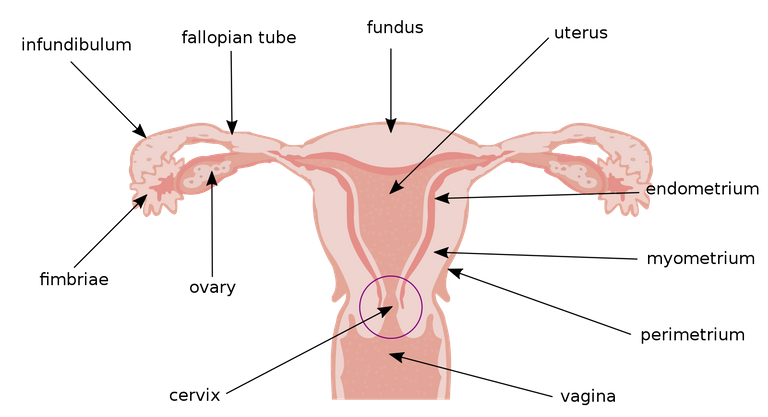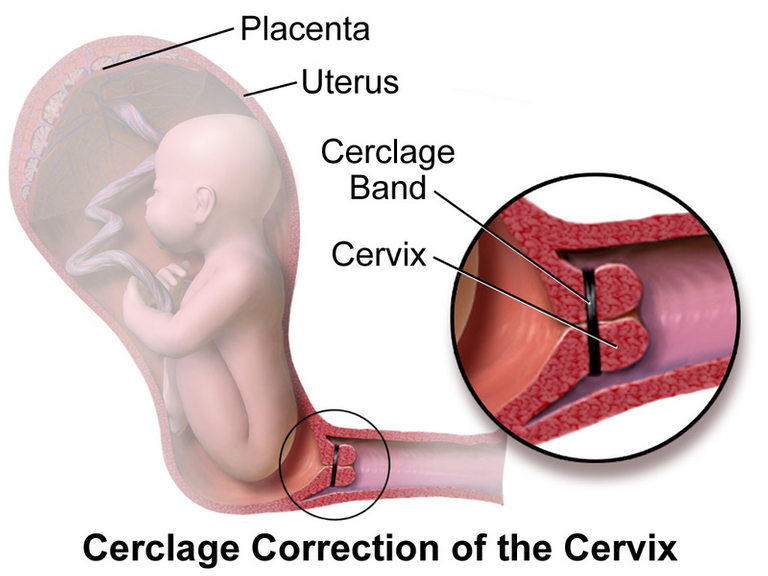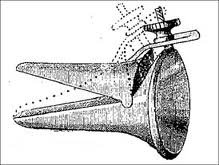Cervical cerclage a remedy to cervical incompetence in women.
Hello hivers, greetings to everyone, I hope we are all doing well? Am really happy that I have another great opportunity to discuss with us this important topic. Previously, most of my posts focused on babies and children, Though it wasn't out of place, but today I decided to digress a bit to another angle which is midwifery. So I will be discussing about women today and I encourage everyone of us including the men, to pay attention to this important discuss because the knowledge gained here may directly or indirectly benefit you majorly.
So back to our discussion for today,my main focus is to explain cervical cerclage which is also known as cervical stitching but before I delve into it I will be explaining what cervical incompetence is about and how cervical cerclage is a solution to it.
Cervical incompetence.
Cervical incompetence which is also known as cervical insufficiency, is a condition in women where by the cervix which is the neck of the uterus(womb) loses it's original nature of being closed and firm, and now becomes weak, loose and open, making it unable to hold back the baby in the womb during pregnancy, resulting in miscarriages and premature delivery.
I know some of us will still be wondering what the cervix is, what it looks like and where it's located in the body of a woman, so let me briefly describe the cervix as seen in the female reproductive system.
The cervix is known simply as the neck of the uterus (womb)and it has two openings which is known as the cervical Os the internal os which is connected directly to the womb and the external os which directly leads to the vagina.

The female reproductive system showing the cervix
This cervical OS usually is closed and only have a little opening which is not prominent and serves as a passage for both sperm as well as menstrual fluid, but it's only open and shortened when the pregnancy is term and during the period of labour through the process of effacement (taking up of the cervix) and dilatation (widening of the cervical opening to give way for the passage of the baby and placenta).
With respect to our topic of discussion, the cervix here now during pregnancy is weak, and short and because of that it is open even when it is expected it should be closed inorder to help hold back the baby(fetus) in the womb.
So because it's open,it will allow the baby or product of conception to escape through the opening leading to miscarriage of the pregnancy especially in the first to second trimester or prematured labour and premature delivery. Because of this abnormal condition of the cervix, the pregnancy usually do not stay till term (37 to 38 weeks) because the OS is open. This most times happens recurrently especially in women with previous history, which makes it to be a thing of great concern.
This cervical insufficiency doesn't just surface, it's caused by certain things which includes: birth defects which results to abnormal formation of the womb and the cervix in the woman, injury to the cervix from past pregnancies, abnormally short cervix, previous cervical surgeries etc
This condition poses great risk to the unborn baby, as the pregnancy is not able to stay till maturity which is atleast 37 weeks, resulting in the baby being born prematured which usually comes with its own associated risks in which some times the baby may not be able to survive.
How do you know when one has Cervical insufficiency?
The following symptoms will help in finding out if the woman has an incompetent cervix:
• There will be some episodes of light spotting especially in the first and second trimester of the pregnancy.
• Record of lower abdominal cramps which most times could be severe
• sharp back pains
• much pressure will be felt in the pelvic area.
Aside the above listed symptoms, this condition can also be confirmed through ultrasound scan which is the transvaginal ultrasound scan which will help in visualizing the area to aid easy diagnosis.
Now having a considerable knowledge about cervical insufficiency, I think it's now time for us to look at a way of treating or solving this problem to save the life of the baby. There are several ways of treatment for this condition, but I will be talking about one of the main treatments which is cervical cerclage.
Cervical cerclage
Cervical cerclage is simply a procedure in which a weak and open cervix is closed through stitching during the period of pregnancy, so as to prevent miscarriage or premature delivery of the baby as well as it's accompanying complications.
It is worthy to note that this procedure can be electively done (booked early ahead of time not as a matter of urgency) in which its booked preferably within the second trimester or late first trimester of pregnancy when the fetus (baby) is still small to avoid premature rupturing of the membrane during the procedure. This elective cerclage is usually done for women who are known to have previous history of recurrent miscarriage or premature rupture of membrane inorder to prevent it ahead of time.
On the other hand,this cervical cerclage can also be done as an emergency (as a matter of urgency when there an already threatening situation) which usually comes around the late second trimester of pregnancy or when some of the symptoms of cervical incompetence have been identified, so as to remedy the situation immediately without delay.
It is important to note that the success rate is higher when the procedure is electively done than in emergency situations in which it might still fail also resulting to premature rupture of membrane, there by defeating it's original aim. That is why the former is usually advised.

Illustration of cervical cerclage during pregnancy
Cervical cerclage have different types which are the McDonald cerclage, the shirodkar stitching and the abdominal cerclage.
McDonald cerclage
This type of cerclage is the simplest type to apply and can be done on an out patient basis.
Shirodkar
This type of cerclage is done in a surgical manner through the vagina. It is known to reduce the chances of infection. Just as the stitch is applied surgically, it's removal is also through surgery in a theatre and so it can't be done on out patient basis. This removal is done during the third trimester at term inorder to permit for spontaneous vaginal delivery.
Abdominal cerclage
This type of cerclage is usually known to be a permanent form of cerclage and just as the name goes it's usually done through the abdomen and is used when the other types have failed. In this particular type of stitching, ceaserean section is usually used for the delivery of the baby especially if the cerclage is permanent in order to preserve it.
Cervical stitching can be done through different routes but specifically I will be discussing two main routes and they include:
• Transvaginal cerclage
Here, the application of the stitch is done through the vagina with the help of a speculum which helps in widening the vaginal canal so as to expose the cervix for the procedure. This transvaginal cerclage also be carried out with the guidance of an ultrasound scan during the procedure.
Also, this route is usually adopted for the McDonald's cerclage as well as the shirodkar stitching and is usually done on out patient basis in most cases. Also , the removal is also quite easy when the pregnancy have gotten to term.
• transabdominal cerclage
Just as the name implies, it involves application of the stitch to the cervix so as to close it to prevent miscarriages as well as preterm deliveries and it's done through the abdomen. This route is also used for individuals who have very short cervix.
Now that I have successfully explained briefly what cerclage is all about as well as the types and routes, I will go on with the the procedure for transvaginal cerclage.
Procedure
The procedure for this cerclage is divided into three sections which includes: before the procedure (pre), during the Procedure (intra) and after the procedure (post).
Before the procedure
This section involves obtaining informed consent from the patient and this is done through explaining everything about the procedure including the pros and cons as well as associated risks and benefits by doing so, the anxiety level of the patient is reduced. Proper investigations like ultrasound scan to know the nature of the cervix and pregnancy are carried out and the woman is booked for the cerclage.
During the procedure
When the procedure is about starting, all the instruments like the speculum which will be used for the procedure will be assembled and made ready,

A speculum used in opening the vagina to see the cervix
the woman will be placed on lithotomy position (lying down with the back with both legs spread and suspended on a stirrup as though she wants to put to bed), after which the vaginal orifice is cleaned and then the speculum is gradually inserted and opened up inorder to visualize the cervix clearly to apply the stitch.

The vagina canal widened with a speculum to expose the cervix during the procedure
The anasthesia is applied around the area so as to make it numb, preventing pain after which stitching is done few minutes following the administration of the anasthesia.
Least I forget, this procedure is usually carried out by an obstetrics and gynecologist in the hospital because that's their area of specialty.
After the procedure
As soon as the procedure finishes, the woman is counselled on avoidance of strenuous activities as well as sexual intercourse for few days and some times weeks before they go back home and they are also encouraged to come back for checkups often (weekly in some cases) for proper monitoring of the their condition.
Some women in extreme cases in which the pregnancy is at high risk are even admitted in the hospital after the Procedure for bed rest till the pregnancy gets to 37weeks (term) and this is done inorder to ensure the success of the procedure.
Performing the cervical cerclage or stitching is not the only thing, once the pregnancy gets to term which is around 37 to 38 weeks, the woman is also encouraged to return to the facility for the removal of the stitch especially if she's for normal vaginal delivery inorder to allow the dilatation of the cervix when labour begins to avoid cervical or uterine rupture when labour commence. Also, if the woman is booked for ceaserean section, there will be no need for the removal of the stitches especially if it's the transabdominal cerclage that was done.
Removal of the stitches is done same way with it's application, and most times it takes few days after removal for labour to commence which could be two days to may be 1week plus. It is worthy to note that once the pregnancy has matured to term,there will be no chances of miscarrying it even with the removal of the stitch.
Most procedures have their prons and cons in life, and that is why even with the disadvantages they are still considered because the risk benefit ratio is weighed and once the benefits outweighs the risk, the procedure is carried on. Some of the risks associated with this procedure includes:
infection which could come from poor asepsis during the procedure, bleeding could also occur as a result of the stitching, there could be uterine rupture or laceration as well as that of the cervix which could happen due to late removal of the cerclage before labour commences, preterm rupture of membrane could also occur which could result to premature labour and delivery and this could be from failure of the procedure.
That will be all for cervical incompetence and cerclage. I know that atleast we now have basic knowledge about Cervical incompetence as well as cerclage as a form of treatment. Thanks a bunch for the time, I look forward to your supports and contributions.
Reference
• cervical cerclage and effects
• causes of cervical cerclage failure
• causes of incompetent cervix
Very interesting post! Thanks for your contribution to the community!
!1UP
You have received a 1UP from @kwskicky!
@stem-curator, @vyb-curator, @pob-curator, @neoxag-curator, @pal-curatorAnd they will bring !PIZZA 🍕
Learn more about our delegation service to earn daily rewards. Join the family on Discord.
Congratulations @nazom! You have completed the following achievement on the Hive blockchain and have been rewarded with new badge(s):
Your next target is to reach 200 upvotes.
You can view your badges on your board and compare yourself to others in the Ranking
If you no longer want to receive notifications, reply to this comment with the word
STOPTo support your work, I also upvoted your post!
Check out the last post from @hivebuzz:
Support the HiveBuzz project. Vote for our proposal!
Thanks for your contribution to the STEMsocial community. Feel free to join us on discord to get to know the rest of us!
Please consider delegating to the @stemsocial account (85% of the curation rewards are returned).
You may also include @stemsocial as a beneficiary of the rewards of this post to get a stronger support.